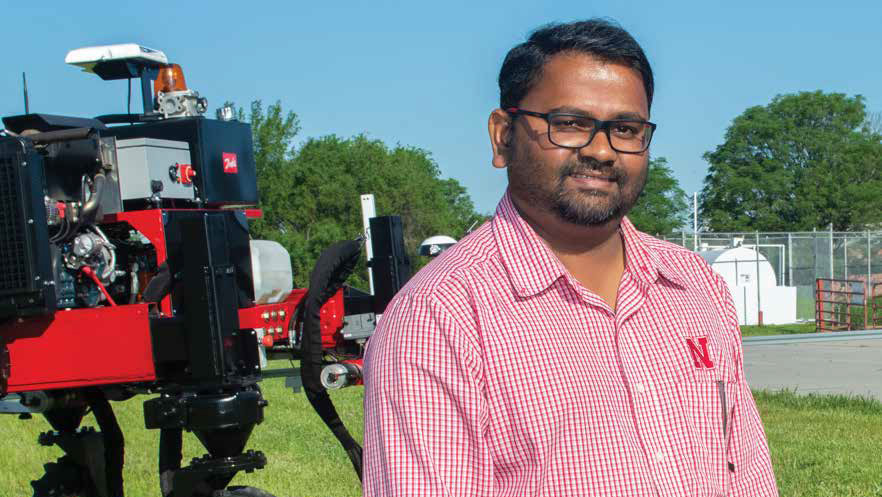
Driverless Tractors: Coming Soon to a Field Near You
A New Age in Agriculture

Technology around the world is becoming more advanced every year and the agricultural industry is no exception. Santosh Pitla, associate professor of advanced machinery systems in the Department of Biological Systems Engineering at the University of Nebraska–Lincoln, is currently developing an autonomous tractor using ground robotics.
“We’re almost getting to a point where we can easily take the operator out and see the machines operating by themselves,” Pitla said. “There is a need on the farm for automation because statistics suggest that only 2% of the population in the United States are farmers.” With so few people working to provide food for the world, tractor automation is key for producers to keep up with growing demands.
The idea of autonomous tractors began in the mid-2000s and has developed to a near reality. Pitla’s research looks to transform tractors from larger, higher horsepower engines to smaller, low horsepower machines that may become fully electronic.
Pitla and his team are currently working on one of the only autonomous tractors of its kind in the country. Named Flexible Structured Robotic Vehicle (FlexRo), the tractor is currently used for plant phenotyping, which is measuring the physical characteristics of the plant. According to Pitla, cameras are added to the machine to collect images that characterize plant conditions.
In addition to phenotyping, the FlexRo platform has enough power to perform other operations such as two row planting and targeted weeding (both mechanical and chemical).
Autonomous Tractor Design
Non-autonomous tractors can have engines ranging from 100- to 600-horsepower. These are large machines to send into a field without an operator to manage the systems. A solution to this problem is a scale-neutral tractor, or rather shrinking the large machines to smaller sizes.
“One of the things we are looking at is if we can replace a 500-horsepower tractor with 10, 50-horsepower tractors,” Pitla said. Many safety features would be added to the machine, like sensors to detect surrounding objects or prevent a “mechanical fault,” or machine malfunction. Pitla said mechanical faults are likely but believes having a smaller, lower horsepower tractor will drastically lower the damage done by a machine fault.
Safety of Autonomous Tractors
Pitla said that in 2005, auto-steer technology, in which a computer system controls the machine with GPS guidance, took a strong hold of the agriculture industry and was widely adopted by farmers. The idea of removing the operator completely from the machine began to form. Since then, systems have become more automated and the operator has fewer tasks to perform. Safety remains the most important concern as the idea continues to develop.
“When you take an operator out of the machine, the biggest challenge is safety and liability,” Pitla said. Technology has continued to advance, such as a machine’s computing power and machine learning systems.
Ultimately, the advancement of these systems in agriculture makes the idea of autonomous tractors possible. As of 2019, autonomous tractors are not commercially available. Unmanned vehicles are quite possibly the way of the future for the agriculture industry, and FlexRo is the first of its kind leading the way.
Flexible Structured Robotic Vehicle: An Autonomous Tractor
The development of FlexRo began in 2015 and Pitla has been a part of the development team since its inception. FlexRo is a 46-horsepower robotic machine with four-wheel drive and four-wheel steering. The machine has a 10-foot by 10-foot frame and has a ground clearance of 5 feet. FlexRo’s footprint addresses the safety concerns of size. FlexRo is a machine that few other universities in the United States are developing.
Pitla said the current goal is to phenotype plants. This includes growth, physical characteristics, chlorophyll content, and stressors to the plant, and this can all be measured with FlexRo. As the technology progresses, new testing practices will need to be developed to measure a machine’s computing capacities. Instead of testing machines based on their physical power, such as pulling power or fuel efficiency, these machines will need to be tested on their ability to process information, or rather their thinking power.
FlexRo not only removes the need to have an operator in the field, it also saves time and energy through more efficient operating patterns. “In a field, the biggest inefficiency from the machinery perspective is turning around at the end of the row, but with FlexRo you have four-wheel steering, so you can run in different configurations to save time in terms of turning,” Pitla said.
Further, FlexRo also provides the ability to operate for 20 hours a day since it is autonomous and does not need an operator. Being only a 46-horsepower machine also reduces soil compaction compared to a much larger tractor. There are many advantages to having autonomous vehicles in agriculture production, but Pitla said there are still questions that need to be answered regarding costs.
(photo/graphic of FlexRo here)
Technology Cost
Tractors can range from tens to hundreds of thousands of dollars and adding an autonomous component will indeed raise prices. Pitla said that to understand the cost of this technology an economic analysis needs to be completed for each individual operation.
Looking at a general agricultural budget for producers, Pitla can see benefits to the technology for two distinct reasons. First, autonomous tractors could improve the accuracy of application operations, which would cut back on seed and chemical costs. Second, conventional tractors are designed to include office-like features for comfortability. However, an autonomous tractor would not need any of these features. This could offset the higher prices. For instance, “air conditioning, cab, active suspension, radio and leather seating are all expensive,” Pitla said. Removing these amenities will remove a large sum from the cost of building one of these machines. These two factors would reduce the impact an autonomous tractor purchase would have on a farmer’s overall budget.
The Future of Autonomous Tractors
Nebraska is home to the only tractor-testing laboratory in the western hemisphere. The Nebraska Tractor Testing Laboratory in the Department of Biological Systems Engineering opened in 1919. The laboratory was a result of Nebraska legislation that stated every tractor sold in the state had to be performance tested. This requirement was to protect farmers from buying equipment that had lesser abilities than advertised. As autonomous tractor technology continues to develop, new testing practices will also need to be developed to evaluate the machine’s capabilities. This may even include testing in fields, rather than in the laboratory.
With less than 2% of the United States population actively farming, autonomous tractors will allow producers to better meet the demand for food around the world. While Pitla estimates a timeline of 5 to 10 years before fully autonomous tractors are available for farmers, smaller developments will likely be introduced to the public in increments. The steps of this gradual introduction could unfold in several different ways. Pitla believes it is likely that test producers will direct a few autonomous vehicles as part of their operations. Several trial runs will follow with selected producers, starting with a few machines and gradually progressing to a fully automated system.